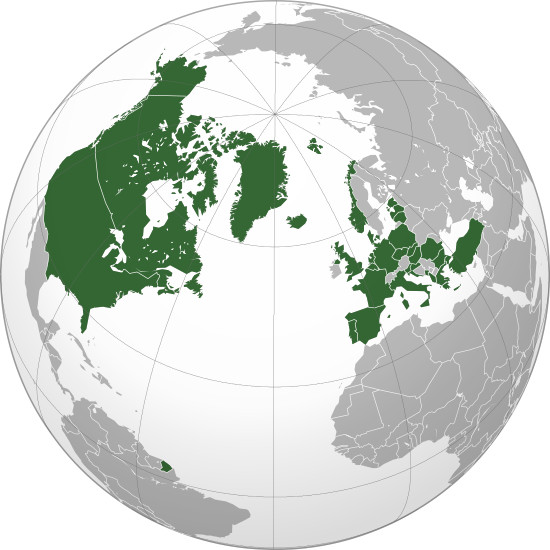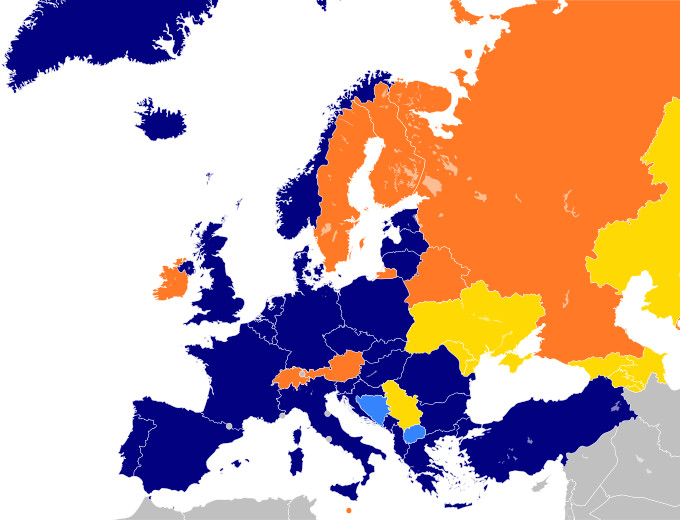Among us, everyone has probably heard the name NATO at least once in their life, but do you know what NATO is? The following article will clarify your questions about NATO; we invite you to refer to it.
Essential Information about NATO
What is NATO?
NATO stands for the North Atlantic Treaty Organization (in English: North Atlantic Treaty Organization; in French: Organisation du Traité de l’Atlantique Nord, abbreviated as OTAN). It is a military alliance established in 1949, consisting of the United States and several European countries. Its headquarters is located in Brussels, Belgium, and the organization establishes a defensive alliance in which member countries engage in collective defense when attacked from outside.

NATO Logo.
Overview of NATO
The establishment of NATO led to the formation of the Warsaw Pact by socialist countries in Eastern Europe as a counterbalance. The rivalry and arms race between these two opposing military blocs were the main confrontations of the Cold War in the latter half of the 20th century.
The treaty stipulates that in the event of an “armed attack” against one or more member countries, the other countries must promptly assist, including the use of armed forces. The highest authority is the NATO Council, alongside the Defense Planning Committee, which consists of defense ministers responsible for formulating unified military plans and policies. Militarily, the highest authority is the Military Committee, comprising the chiefs of staff of member countries, headed by the NATO Secretary-General. In addition to the armed forces of each country, NATO has unified forces under the command of the Allied Command.
Within NATO, the United States and its armed forces play a leading role. Key positions in the Allied Command and in the unified armed forces are held by American generals and admirals. The Supreme Allied Commander of NATO is an American. Since its establishment, NATO has consistently pursued a policy of strengthening arms races in preparation for war, particularly increasing nuclear capabilities, leading to a state of ongoing tension in Europe and worldwide. After the Warsaw Pact was dissolved in 1991, NATO asserted its continued existence while undergoing structural reforms, expanding its membership to include most countries from the Warsaw Pact, some former Soviet states, and Yugoslavia, increasing the total number of members to 28 to enhance its role in the region and globally.
On April 4, 1949, the United States, Canada, and ten Western European countries signed the Washington Treaty establishing NATO (including: Belgium, Canada, Denmark, France, Iceland, Italy, Luxembourg, the Netherlands, Norway, Portugal, the United Kingdom, and the United States). Article 5 of this treaty states that member countries “agree that an armed attack against one or more NATO countries in Europe or North America shall be considered an attack against all member countries.”
On May 6, 1955, West Germany joined NATO (after the reunification of Germany, membership was extended to include the former German Democratic Republic in 1990). Eight days later, on May 14, 1955, the Soviet Union and eight Eastern European countries established the Warsaw Pact. On March 10, 1966, President Charles de Gaulle withdrew France from NATO’s unified command structure. The following year, NATO moved its headquarters from Paris to Brussels (Belgium).
From December 9 to 10, 1976, NATO rejected proposals from the Warsaw Pact to renounce the first use of nuclear weapons and limit membership. In the first 20 years, NATO spent over three billion USD to build infrastructure for the organization, including military bases, airports, pipelines, information networks, and storage facilities. The United States contributed about one-third of this amount. On December 19, 1990, after the end of the Cold War, NATO and the Warsaw Pact issued a joint declaration of non-aggression.
Eight months later, the Warsaw Pact was officially dissolved. On December 16, 1995, NATO launched its largest military campaign to date in support of the peace agreement in Bosnia. On March 24, 1999, NATO began airstrikes against Yugoslavia in Kosovo, marking the first time this military alliance used force against a sovereign nation without United Nations approval.
On September 12, 2001, NATO invoked Article 5 for the first time following the terrorist attacks against the United States on September 11, 2001, deploying air defense control and warning systems in the U.S. On August 11, 2003, NATO took on peacekeeping forces in Afghanistan based in Kabul. This was the first time NATO deployed its forces “outside the region.” On June 31, 2006, NATO forces took over security from the U.S.-led coalition in southern Afghanistan, beginning one of the most challenging operations in the history of this military bloc. From April 2 to 4, 2008, NATO declared that the former Soviet republics such as Georgia and Ukraine would one day join NATO.
In 2009: On March 5, NATO agreed to resume high-level relations with Russia, which had been cut off at the end of 2008 after Moscow briefly invaded Georgia; On March 11, French President Nicolas Sarkozy announced that Paris would rejoin NATO’s unified command structure; On April 3 and 4, NATO celebrated its 60th anniversary organized by France and Germany. Croatia and Albania joined NATO; On August 1, former Danish Prime Minister Anders Fogh Rasmussen was appointed the 12th NATO Secretary-General; On September 18, NATO proposed a new era of cooperation with the U.S. and Russia, calling for the joint deployment of a missile defense system after Washington canceled its missile defense plan; On December 4, NATO proposed an official membership plan for Montenegro while still extending an invitation for Bosnia to join the organization.
In 2010: On April 6, Ukrainian President Viktor Yanukovych canceled the consideration of NATO membership for Ukraine; On July 23, Russia announced its readiness to re-establish military cooperation with NATO after nearly two years of stalled relations during the armed conflict in Georgia; On October 1, NATO Secretary-General Rasmussen declared that the door to NATO membership remains open for Georgia, despite efforts by Tbilisi to improve relations with Moscow; On October 7, NATO announced plans to spend 930 million euros (1.3 billion USD) in 2011-2012 on projects including cybersecurity and missile defense technology…;
On October 29, NATO announced that it would reduce its forces in Kosovo from ten thousand to five thousand in the coming months due to improved security; On November 3, after a meeting between Russian President Dmitry Medvedev and NATO Secretary-General Rasmussen, Russia committed to enhancing cooperation with NATO in Afghanistan and reviewing the joint missile defense system.
The Purpose of NATO’s Establishment
The purpose of NATO’s establishment was to prevent the spread of communism and the influence of the Soviet Union, which was then on the rise in Europe, from jeopardizing the security of member countries. The establishment of NATO led communist countries to form the Warsaw Pact as a counterbalance. The rivalry and arms race between these two opposing military blocs were the main confrontations of the Cold War in the latter half of the 20th century.
In its early years, NATO was merely a political alliance. However, due to the impact of the Korean War, a unified military organization was established. Doubts about the weakening ties between European countries and the U.S., as well as NATO’s defensive capabilities against the Soviet expansion, led France to withdraw from NATO in 1966. In 2009, with an overwhelming vote from Parliament under President Nicolas Sarkozy’s leadership, France returned to NATO.
After the fall of the Berlin Wall in 1989, the organization was drawn into the division of Yugoslavia and participated militarily in Bosnia and Herzegovina from 1992 to 1995. It later bombed Serbia in 1999 during the Kosovo civil war. The organization also established better relations with countries from the previously opposing bloc, many of which were former Warsaw Pact members that joined NATO from 1999 to 2004.
On April 1, 2009, the number of members rose to 28 with the accession of Albania and Croatia. Since the events of September 11, 2001, NATO has focused on new challenges, including deploying troops to Afghanistan and Iraq.

NATO countries highlighted in green.
NATO’s military spending accounts for 70% of global military expenditure, with the United States alone accounting for about 50%, while the combined expenditures of the United Kingdom, France, Germany, and Italy account for 15% of global military spending.
NATO Members
Founding Members
- United Kingdom
- Belgium
- Portugal
- Canada
- Denmark
- Netherlands
- United States
- Iceland
- Luxembourg
- Norway
- France
- Italy
Cold War Members
- Greece (February 18, 1952)
- Turkey (February 18, 1952)
- Federal Republic of Germany (May 9, 1955)
- Spain (May 30, 1982)
Eastern European Members Post-Cold War
- Poland (May 27, 1999)
- Czech Republic (May 27, 1999)
- Hungary (May 27, 1999)
- Bulgaria (March 29, 2004)
- Estonia (March 29, 2004)
- Latvia (March 29, 2004)
- Lithuania (March 29, 2004)
- Romania (March 29, 2004)
- Slovakia (March 29, 2004)
- Slovenia (March 29, 2004)
- Croatia (April 1, 2009)
- Albania (April 1, 2009)

NATO in Europe.
Greece and Turkey joined the organization in February 1952. In 1955, the Federal Republic of Germany (then only West Germany) became a member, and in 1990, a unified Germany extended membership to the territory of East Germany, formerly known as the German Democratic Republic. Spain joined on May 30, 1982. In 1999, three former Warsaw Pact countries—Poland, the Czech Republic, and Hungary—joined NATO.
France is a NATO member but withdrew from the military command in 1966. Subsequently, NATO’s headquarters moved from Paris to Brussels. In April 2009, France returned to NATO’s military command, becoming a full member again after 43 years of absence. Iceland is the only NATO member without its own military; therefore, the permanent U.S. military presence in Iceland serves as the Icelandic Defense Force.
On March 29, 2004, Slovenia, Slovakia, and former Warsaw Pact countries including Bulgaria, Romania, and the Baltic states of Estonia, Latvia, and Lithuania officially joined NATO. In April of the same year, these countries participated in a NATO council meeting for the first time.
On April 1, 2009, Croatia and Albania were officially inducted into NATO after a year of applying for membership.
















































